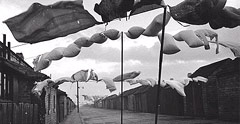
| HOME |
| NERVE |
| REVIEWS |
| ARCHIVE |
| EVENTS |
| LINKS |
| ABOUT US |
| CONTRIBUTORS |
| BACK ISSUES |
| CONTACT US |
 Making
History: Art and Documentary in Britain from 1929 to Now
Making
History: Art and Documentary in Britain from 1929 to Now
Tate Liverpool, Albert Dock
3rd February - 23rd April 2006 (Tue-Sun 10:00-17:50)
£4 (£3 concessions), free for Tate members
Reviewed by Lib Murray
Encompassing film, photography, painting and installation art, Tate Liverpool’s current exhibition aims 'to question the traditional opposition between art and documentary'. Ranging from the political to the personal, with a piece on the 1984-5 miners’ strike to snapshots of since-demolished northern streets, it seeks out the art in documentary.
Jeremy Deller's 'The Battle of Orgreave Archive (An Injury To One Is An Injury to All' (2001) is a striking example of this. Amid the archive is a police shield, with a hand-written account of its purpose fixed to it. Not only does the handwriting immediately personalise the object, but the account also forces the viewer to stand still and read at the point of so much past violence and frustration. As such the personal invades the political, and art is created from history.
As well as blurring boundaries on a thematic level, the exhibition explores the very nature of documentaries. Gillian Wearing's film '10-16' (1997) looks at the relationship between filmmaker and subject and how this can be manipulated. In her film, adults lip-synch to the words of children. In one, the voice of a vulnerable adolescent - insecure about his looks and his sexuality - is lip-synched through a middle-aged, middle class, white man, and so the perceptions and prejudices the viewer brings to each subject is challenged.
The Amber Collective - founded in 1969 in the north east of England - sought to document and preserve working class life in its region. Sirkka-Liisa Konttinen’s photographs of Byker, Newcastle - 'Issac in front of his shop' (1974), and 'Heather playing a piano in a derelict house' (1971) - reveal a startling bond between subject and artist. In documenting this working class community, Konttinen has added them to a history from which they could so easily have been omitted. The concept of images documented from a position of trust and understanding is developed further in 'Untitled 1,2 and 3' (1996) - Richard Billingham's wonderfully intimate photographs of his family.
So does the exhibition achieve its aim of unifying art and documentary? Humphrey Spender’s photograph of a washing line in 1930s Bolton has a poetic beauty to it that belies its subject matter. Furthermore, Julian Trevelyan’s painting 'The Potteries' (1938) is an expressively distorted image of a world which was 'full of drama and pathos'. Pioneering filmmaker John Grierson defined documentary as “the creative use of actuality”. Consequently, each documented piece bears-out its creator’s own personal vision - as any work of art does - leaving the viewer with a myriad of meanings to choose from.
Printer friendly page